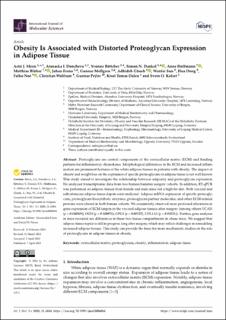| dc.contributor.author | Meen, Astri Jeanette | |
| dc.contributor.author | Doncheva, Atanaska Ivanova | |
| dc.contributor.author | Böttcher, Yvonne | |
| dc.contributor.author | Dankel, Simon N | |
| dc.contributor.author | Hoffmann, Anne | |
| dc.contributor.author | Blüher, Matthias | |
| dc.contributor.author | Fernø, Johan | |
| dc.contributor.author | Mellgren, Gunnar | |
| dc.contributor.author | Ghosh, Adhideb | |
| dc.contributor.author | Sun, Wenfei | |
| dc.contributor.author | Dong, Hua | |
| dc.contributor.author | Noé, Falko | |
| dc.contributor.author | Wolfrum, Christian | |
| dc.contributor.author | Pejler, Gunnar | |
| dc.contributor.author | Dalen, Knut Tomas | |
| dc.contributor.author | Kolset, Svein Olav | |
| dc.date.accessioned | 2023-08-10T12:00:30Z | |
| dc.date.available | 2023-08-10T12:00:30Z | |
| dc.date.created | 2023-06-26T13:20:19Z | |
| dc.date.issued | 2023 | |
| dc.identifier.issn | 1661-6596 | |
| dc.identifier.uri | https://hdl.handle.net/11250/3083372 | |
| dc.description.abstract | Proteoglycans are central components of the extracellular matrix (ECM) and binding partners for inflammatory chemokines. Morphological differences in the ECM and increased inflammation are prominent features of the white adipose tissues in patients with obesity. The impact of obesity and weight loss on the expression of specific proteoglycans in adipose tissue is not well known. This study aimed to investigate the relationship between adiposity and proteoglycan expression. We analyzed transcriptomic data from two human bariatric surgery cohorts. In addition, RT-qPCR was performed on adipose tissues from female and male mice fed a high-fat diet. Both visceral and subcutaneous adipose tissue depots were analyzed. Adipose mRNA expression of specific proteoglycans, proteoglycan biosynthetic enzymes, proteoglycan partner molecules, and other ECM-related proteins were altered in both human cohorts. We consistently observed more profound alterations in gene expression of ECM targets in the visceral adipose tissues after surgery (among others VCAN (p = 0.000309), OGN (p = 0.000976), GPC4 (p = 0.00525), COL1A1 (p = 0.00221)). Further, gene analyses in mice revealed sex differences in these two tissue compartments in obese mice. We suggest that adipose tissue repair is still in progress long after surgery, which may reflect challenges in remodeling increased adipose tissues. This study can provide the basis for more mechanistic studies on the role of proteoglycans in adipose tissues in obesity. | en_US |
| dc.language.iso | eng | en_US |
| dc.publisher | MDPI | en_US |
| dc.rights | Navngivelse 4.0 Internasjonal | * |
| dc.rights.uri | http://creativecommons.org/licenses/by/4.0/deed.no | * |
| dc.title | Obesity Is Associated with Distorted Proteoglycan Expression in Adipose Tissue | en_US |
| dc.type | Journal article | en_US |
| dc.type | Peer reviewed | en_US |
| dc.description.version | publishedVersion | en_US |
| dc.rights.holder | Copyright 2023 The Author(s) | en_US |
| dc.source.articlenumber | 6884 | en_US |
| cristin.ispublished | true | |
| cristin.fulltext | original | |
| cristin.qualitycode | 1 | |
| dc.identifier.doi | 10.3390/ijms24086884 | |
| dc.identifier.cristin | 2158051 | |
| dc.source.journal | International Journal of Molecular Sciences | en_US |
| dc.identifier.citation | International Journal of Molecular Sciences. 2023, 24 (8), 6884. | en_US |
| dc.source.volume | 24 | en_US |
| dc.source.issue | 8 | en_US |

